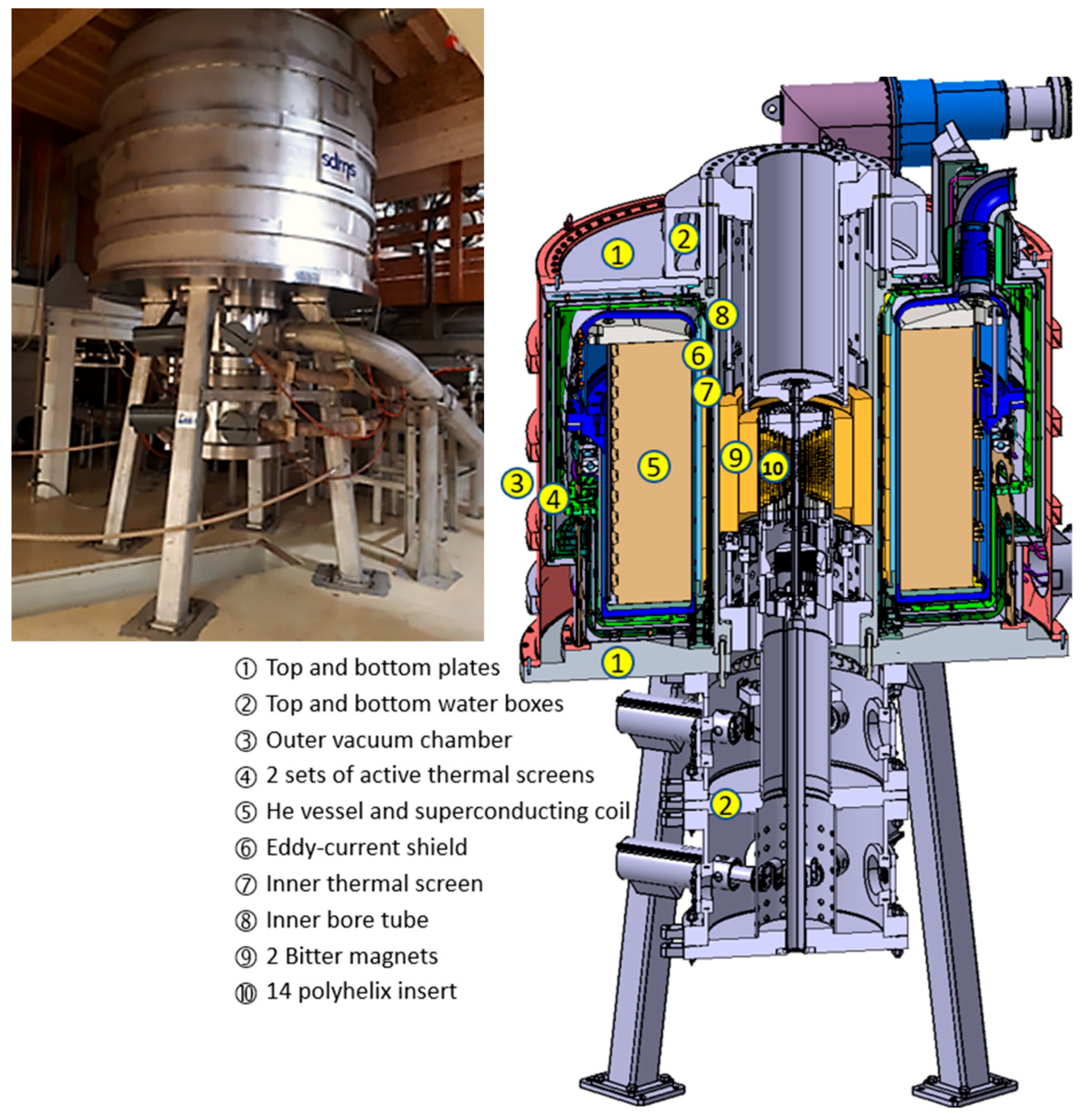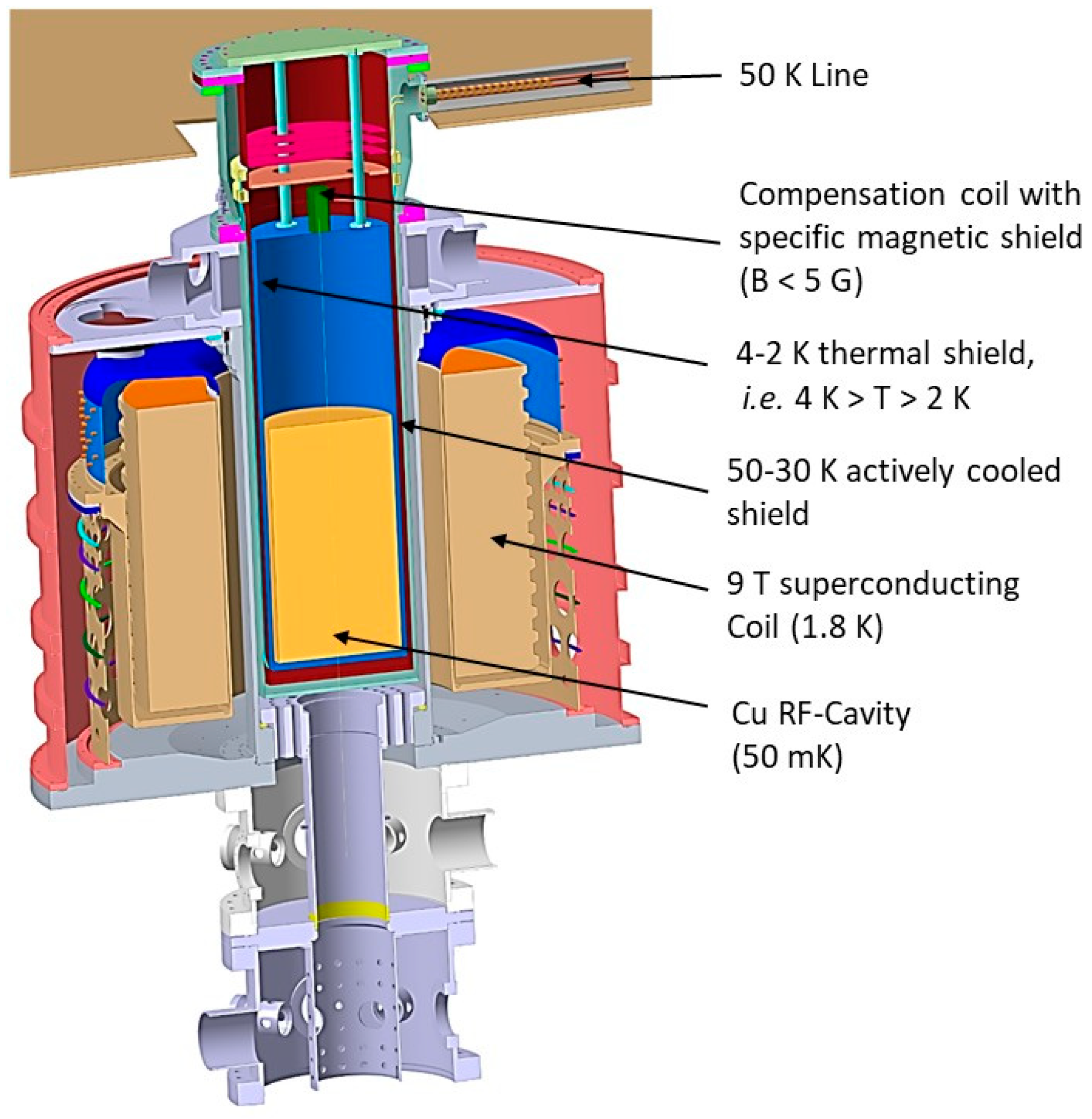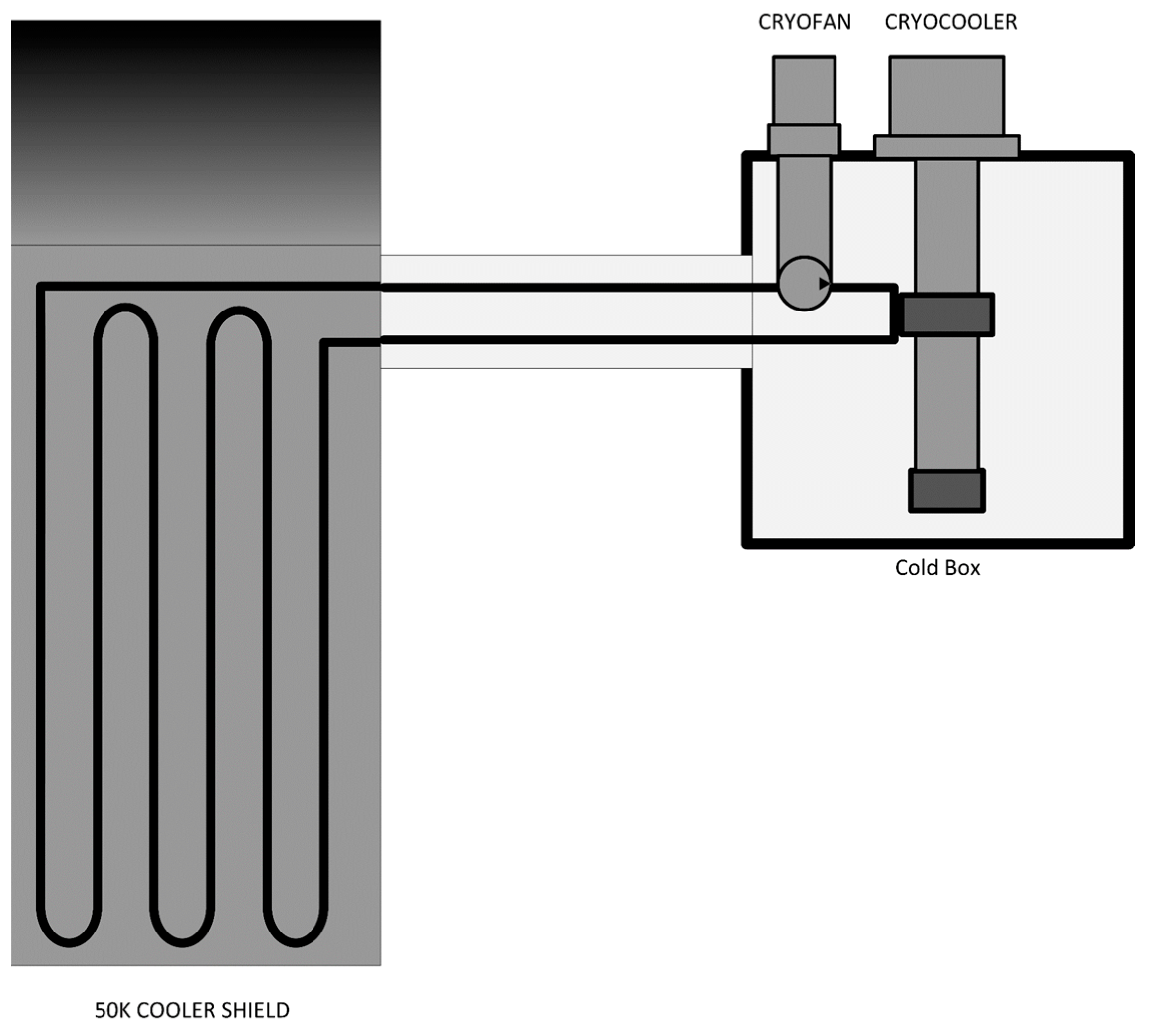Progress in GrAHal-CAPP/DMAG for Axion Dark Matter Search in the 1–3 μeV Range †
Abstract
1. Introduction
2. The Modular Grenoble Hybrid Magnet Platform of LNCMI
3. Haloscope Cryostat for Cooling the Cu RF-Cavity and First-Stage RF-Amplification
3.1. Generalities
3.2. Main Changes and Improvements
3.2.1. Removal of the Lower Part of the 300 K Shield
3.2.2. 50–30 K Actively Cooled Shield with Its Cooling Loop System
3.2.3. Cryogenic Link and JT2K System
4. Targeted Sensitivities Versus Frequency Range
Supplementary Materials
Author Contributions
Funding
Institutional Review Board Statement
Informed Consent Statement
Data Availability Statement
Acknowledgments
Conflicts of Interest
Abbreviations
| ALP(s) | Axion like particle(s) |
| CP | Charge parity symmetry |
| Cu | Copper |
| DFSZ | Dine–Fischler–Srednicki–Zhitnitskii limit |
| DMAG | Dark Matter search Axion Group |
| DR1/2 | Dilution refrigerator 1/2 |
| GrAHal | Grenoble Axion Haloscopes |
| HeII | Superfluid helium |
| JT2K/4K | Joule–Thomson 2K/4K cooling system |
| LHC | Large Hadron Collider |
| SQUID | Superconducting Quantum Interference Device |
References
- Weinberg, S. A New Light Boson? Phys. Rev. Lett. 1978, 40, 223. [Google Scholar] [CrossRef]
- Wilczek, F. Problem of strong P and T invariance in the presence of instantons. Phys. Rev. Lett. 1978, 40, 279. [Google Scholar] [CrossRef]
- Peccei, R.-D.; Quinn, H.-R. CP Conservation in the Presence of Pseudoparticles. Phys. Rev. Lett. 1977, 38, 1440–1443. [Google Scholar] [CrossRef]
- Svrek, P.; Witten, E. Axions in String Theory. J. High Energy Phys. 2006, 2006, 051. [Google Scholar] [CrossRef]
- Kim, J.-E. Weak-Interaction Singlet and Strong CP Invariance. Phys. Rev. Lett. 1979, 43, 103. [Google Scholar] [CrossRef]
- Cicoli, M.; Goodsell, M.; Ringwald, A. The type IIB string axiverse and its low-energy phenomenology. J. High Energy Phys. 2012, 2012, 146. [Google Scholar] [CrossRef]
- Abbott, L.-F.; Sikivie, P. A cosmological bound on the invisible axion. Phys. Lett. B 1983, 120, 133. [Google Scholar] [CrossRef]
- Bradley, R.; Clarke, J.; Kinion, D.; Rosenberg, L.J.; van Bibber, K.; Matsuki, S.; Mück, M.; Sikivie, P. Microwave cavity searches for dark-matter axions. Rev. Mod. Phys. 2003, 75, 777–817. [Google Scholar] [CrossRef]
- Arias, P.; Cadamuro, D.; Goodsell, M.; Jaeckel, J.; Redondo, J.; Ringwald, A. WISPy cold dark matter. J. Cosmol. Astropart. Phys. 2012, 6, 013. [Google Scholar] [CrossRef]
- Ringwald, A. Exploring the Role of Axions and Other WISPs in the Dark Universe. Dark Universe 2012, 1, 116. [Google Scholar] [CrossRef]
- Navas, S.; Amsler, C.; Gutsche, T.; Hanhart, C.; Hernández-Rey, J.J.; Lourenço, C.; Masoni, A.; Mikhasenko, M.; Mitchell, R.E.; Patrignani, C.; et al. (Particle Data Group). The Review of Particle Physics. Phys. Rev. D 2024, 110, 030001. [Google Scholar] [CrossRef]
- Meyer, M.; Horns, D.; Raue, M. First lower limits on the photon-axion-like particle coupling from very high energy gamma-ray observations. Phys. Rev. D 2013, 87, 035027. [Google Scholar] [CrossRef]
- Miller Bertolami, M.-M.; Melendez, B.E.; Althaus, L.G.; Isern, J. Revisiting the axion bounds from the Galactic white dwarf luminosity function. J. Cosmol. Astropart. Phys. 2014, 10, 069. [Google Scholar] [CrossRef]
- Cicoli, M.; Conlon, J.-P.; Marsh, M.-C.-D.; Rummel, M.A. 3.55 keV Photon Line and its Morphology from a 3.55 keV ALP Line. Phys. Rev. D 2014, 90, 023540. [Google Scholar] [CrossRef]
- Sikivie, P. Experimental Tests of the “Invisible” Axion. Phys. Rev. Lett. 1983, 51, 1415, Erratum in Phys. Rev. Lett. 1984, 52, 695. [Google Scholar] [CrossRef]
- Dicke, R.-H. The Measurement of Thermal Radiation at Microwave Frequencies. Rev. Sci. Inst. 1946, 17, 268–275. [Google Scholar] [CrossRef] [PubMed]
- Pugnat, P.; Camus, P.; Kwon, O.; Ballou, R.; Bruyère, C.; Byun, H.; Chung, W.; Grenet, T.; Perrier, P.; Semertzidis, Y.K.; et al. GrAHal-CAPP for axion dark matter search with unprecedented sensitivity in the 1–3 μeV mass range. Front. Phys. 2024, 12, 1358810. [Google Scholar] [CrossRef]
- Schneider-Muntau, H.J. Polyhelix magnets. IEEE Trans. Magn. 1981, 17, 1775–1778. [Google Scholar] [CrossRef]
- Bitter, F. The Design of powerful electromagnets part II. The magnetizing coil. Rev. Sci. Instrum. 1936, 7, 482–488. [Google Scholar] [CrossRef]
- Pugnat, P.; Abir, H.; Barbier, R.; Berriaud, C.; Debray, F.; Grandclément, C.; Hervieu, B.; Juster, F.P.; Krämer, S.; Krupko, Y.; et al. The Grenoble Hybrid Magnet Reached 42 T as a First Step. IEEE Trans. Appl. Supercond. 2025; submitted for publication. [Google Scholar]
- Pugnat, P.; Barbier, R.; Debray, F.; Grandclément, C.; Krämer, S.; Molinié, F.; Pfister, R.; Ronayette, L.; Vincent, B.; Simon, C. The Grenoble Hybrid Magnet: From Commissioning to First Operation up to 42 T. IEEE Trans. Appl. Supercond. 2025; submitted for publication. [Google Scholar]
- Grenet, T.; Ballou, R.; Basto, Q.; Martineau, K.; Perrier, P.; Pugnat, P.; Quevillon, J.; Roch, N.; Smith, C. The Grenoble Axion Haloscope platform (GrAHal): Development plan and first results. arXiv 2021, arXiv:2110.14406. [Google Scholar] [CrossRef]




| Field in T (Nominal Field) | Warm dia. in mm | Grenoble Hybrid Magnet Configurations | Electrical Power in MW 2 |
|---|---|---|---|
| 42 (43) 1 | 34 | 14 helix + 2 Bitter + superc. | 20.7 + 2.8 + 0.4 |
| 34 (35) | 34 | 14 helix + superc. | 10.6 + 1.1 + 0.4 |
| 17.3 (17.5) | 375 | 2 Bitter + superc. | 10.9 + 1.1 + 0.4 |
| 8.5 (9.5) | 812 | Superc. alone | 0.4 3 |
| DR Id | Volume (m3) | Cooling Requirements (μW) | T (mK) |
|---|---|---|---|
| DR1 | 0.466 | 75 | 50 |
| DR2 | 0.008 | 50 | 100 |
Disclaimer/Publisher’s Note: The statements, opinions and data contained in all publications are solely those of the individual author(s) and contributor(s) and not of MDPI and/or the editor(s). MDPI and/or the editor(s) disclaim responsibility for any injury to people or property resulting from any ideas, methods, instructions or products referred to in the content. |
© 2025 by the authors. Licensee MDPI, Basel, Switzerland. This article is an open access article distributed under the terms and conditions of the Creative Commons Attribution (CC BY) license (https://creativecommons.org/licenses/by/4.0/).
Share and Cite
Pugnat, P.; Ballou, R.; Camus, P.; Donnier-Valentin, G.; Grenet, T.; Kwon, O.; Lacipière, J.; Pelloux, M.; Pfister, R.; Semertzidis, Y.K.; et al. Progress in GrAHal-CAPP/DMAG for Axion Dark Matter Search in the 1–3 μeV Range. Phys. Sci. Forum 2025, 11, 3. https://doi.org/10.3390/psf2025011003
Pugnat P, Ballou R, Camus P, Donnier-Valentin G, Grenet T, Kwon O, Lacipière J, Pelloux M, Pfister R, Semertzidis YK, et al. Progress in GrAHal-CAPP/DMAG for Axion Dark Matter Search in the 1–3 μeV Range. Physical Sciences Forum. 2025; 11(1):3. https://doi.org/10.3390/psf2025011003
Chicago/Turabian StylePugnat, Pierre, Rafik Ballou, Philippe Camus, Guillaume Donnier-Valentin, Thierry Grenet, Ohjoon Kwon, Jérôme Lacipière, Mickaël Pelloux, Rolf Pfister, Yannis K. Semertzidis, and et al. 2025. "Progress in GrAHal-CAPP/DMAG for Axion Dark Matter Search in the 1–3 μeV Range" Physical Sciences Forum 11, no. 1: 3. https://doi.org/10.3390/psf2025011003
APA StylePugnat, P., Ballou, R., Camus, P., Donnier-Valentin, G., Grenet, T., Kwon, O., Lacipière, J., Pelloux, M., Pfister, R., Semertzidis, Y. K., Talarmin, A., Vessaire, J., & Youn, S. (2025). Progress in GrAHal-CAPP/DMAG for Axion Dark Matter Search in the 1–3 μeV Range. Physical Sciences Forum, 11(1), 3. https://doi.org/10.3390/psf2025011003





